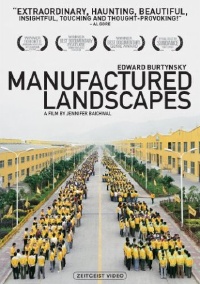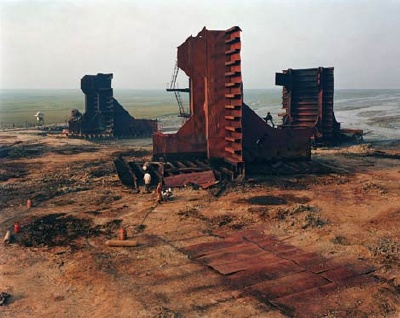 It’s been a quiet week for movies. There just don’t seem to have been many good chances to watch anything. Last night though, we watched a nice documentary called Manufactured Landscapes. Billed as “following around a photographer who focuses on landscapes showing the human effects on nature” or something like that, it wasn’t at all what I would have expected from such an idea. Yes, the photographer (Edward Burtynsky) is being followed around by a film crew as he takes his pictures, but for the most part they are pictures of man-made landscapes. Seemingly, he started in this direction by shooting landscapes that have been changed by man: strip mines, granite quarries and such, and we are shown some of that, but the work documented in this film is more of purely human spaces. Somehow he managed to get great government co-operation, as most of this is filmed in China and Asia, where we are taken to factories, recycling pits, shipyards, the construction site of the Three Gorges dam (and the deconstruction that had to occur for its construction) and the famous ship dismantling beaches of Bangladesh. Though he makes a comment about not having a direct message, instead using the photographs to make people come to their own conclusions, you can’t help but receive a message of human waste and over-consumption as we slowly pan through a vast building as hundreds of workers hand assemble all of these “made in china” goods, the mountains of old tires, computer parts and metal debris that are being “recycled”, we see the shipyards where tankers are built, and the surreal beaches where they are hand disassembled at the ends of their lives.
It’s been a quiet week for movies. There just don’t seem to have been many good chances to watch anything. Last night though, we watched a nice documentary called Manufactured Landscapes. Billed as “following around a photographer who focuses on landscapes showing the human effects on nature” or something like that, it wasn’t at all what I would have expected from such an idea. Yes, the photographer (Edward Burtynsky) is being followed around by a film crew as he takes his pictures, but for the most part they are pictures of man-made landscapes. Seemingly, he started in this direction by shooting landscapes that have been changed by man: strip mines, granite quarries and such, and we are shown some of that, but the work documented in this film is more of purely human spaces. Somehow he managed to get great government co-operation, as most of this is filmed in China and Asia, where we are taken to factories, recycling pits, shipyards, the construction site of the Three Gorges dam (and the deconstruction that had to occur for its construction) and the famous ship dismantling beaches of Bangladesh. Though he makes a comment about not having a direct message, instead using the photographs to make people come to their own conclusions, you can’t help but receive a message of human waste and over-consumption as we slowly pan through a vast building as hundreds of workers hand assemble all of these “made in china” goods, the mountains of old tires, computer parts and metal debris that are being “recycled”, we see the shipyards where tankers are built, and the surreal beaches where they are hand disassembled at the ends of their lives.

Including some glimpses into the lives of those who engage in these occupations (and some interviews) it gives you a fairly thorough picture of the backside of Western Consumerism. As I have always thought, say when looking at the F&#$ You Santa Claus that someone once gave me, “What do these workers in China think of this garbage that they have to assemble and what do they think that the people who create a demand for it must be like?”. In some respects, it can’t help but be viewed as a somewhat critical light on China and the consumption of energy and materials they use, within a seemingly complete lack of environmental regulations. But what it really brings to the fore is the relentless consumption of material crap that the West uses, the long, destructive and wasteful path that those items take to our cupboards, and then out our backdoors to “recycling” and refuse dumps and the terrible toll it takes on the world. But the photography (both film and still) is beautiful, engaging and thought inspiring and whatever conclusions they may bring you to are quite relevant.
